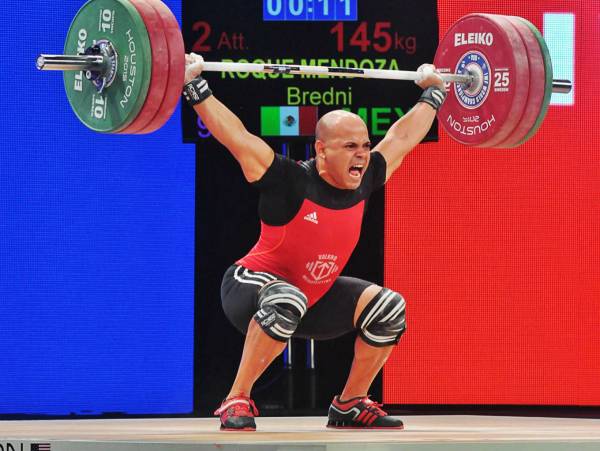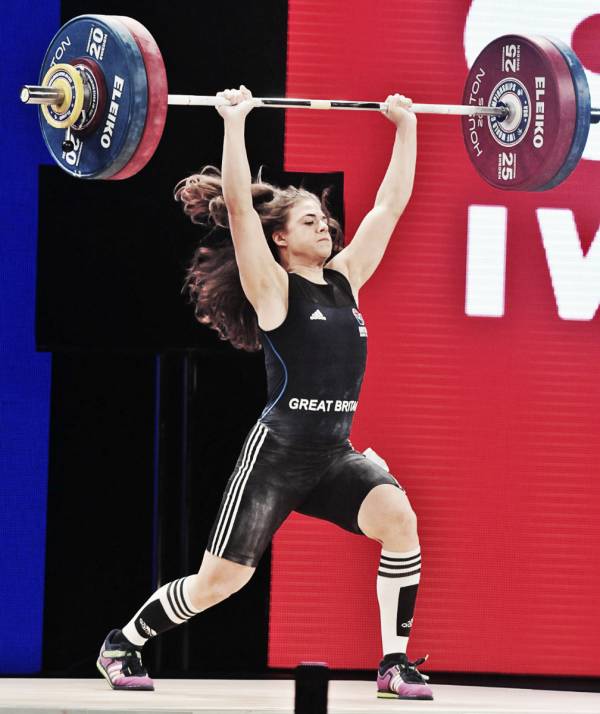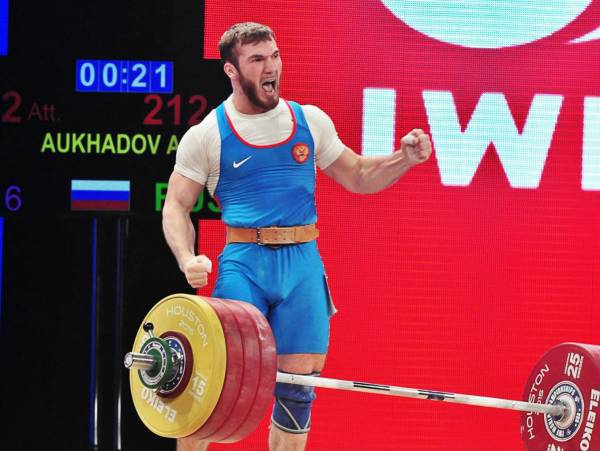The sport of weightlifting is growing. With many CrossFit athletes and fitness enthusiasts of all stripes experimenting with Olympic weightlifting, it is natural that more and more athletes are taking on their first meet or series of meets. USAW (United States Weightlifting) and non-USAW sanctioned weightlifting meets can now be found in almost every city across the country, making this an amazing time for athletes and coaches of all levels to put themselves out on the platform and see what they are made of.
The success or failure of the novice and intermediate lifter at these meets depends on his or her ability to adapt and acclimate to the new sport. Today I’ll discuss the necessary details, and show you how to mentally prepare for the big day.
Me nailing the jerk at a meet. This moment was only the exclamation point on a long, carefully planned day.
Preparing for Weigh-Ins
One to two weeks out from your meet, you should determine where you are with your weight, and in which class you would like to compete. Too often, lifters try to cut too early (or too late), and end up cutting too much weight. Ultimately, this diminishes performance and gains leading up to the meet. Understand the weight classes and where you are to make an accurate and not overly aggressive weight cut.
There are four age groups per gender:
- Youth: 13-17 years old
- Juniors: 15-20 years old
- Seniors: 15 years old and older
- Masters: 35 years and older (with sub-divisions in 5-year increments)
Eight male weight classes:
- 56kg: lifters weighing 56.00kg or less
- 62kg: lifters ≥ 56.01kg, up to 62.00kg
- 69kg: lifters ≥ 62.01kg up to 69.00kg
- 77kg: lifters ≥ 69.01kg up to 77.00kg
- 85kg: lifters ≥ 77.01kg up to 85.00kg
- 94kg: lifters ≥ 85.01kg up to 94.00kg
- 105kg: lifters ≥ 94.01kg up to 105.00kg
- 105kg+: lifters weighing 105.01kg or more
Seven female weight classes:
- 48kg: lifters weighing 48.00kg or less
- 53kg: lifters ≥ 48.01kg up to 53.00kg
- 58kg: lifters ≥ 53.01kg up to 58.00kg
- 63kg: lifters ≥ 58.01kg up to 63.00kg
- 69kg: lifters ≥ 63.01kg up to 69.00kg
- 75kg: lifters ≥ 69.01kg up to 75.00kg
- 75kg+: lifters weighing 75.01kg or more
All athletes weigh in under judge supervision approximately two hours prior to their scheduled start time. If an athlete fails to make the intended weight class, they can compete in the correct weight class that is determined by the weigh-in, or they have exactly one hour to drop into their intended weight class.
Many lifters will try to drop weight to compete at a lower bodyweight class, thinking they will be able to place better. Most athletes can lose 1-2 percent of their body weight leading up to competition, but they must be sure to rehydrate and refuel following their successful weigh-in. Unless you are a highly trained athlete who has prior personal and coaching experience on how to cut weight specifically for power and strength sports, I suggest not trying to drop more than 3 percent of your bodyweight to get into a lower weight class, since you will see marked decreases in performance.

Trying to cut too much weight before a meet will only hinder your power and performance. Get lean, but stay mean.
Planning Your Opening Attempts
Once you have officially weighed in, you will be asked to give your first opening attempt load. This cannot be changed after you give your scorecard to the judge.
Choosing an opening attempt can be tricky. You want to make sure it is a load you can hit consistently in training, even on your bad days. The focus on your first lift is to nail it, get a score in the books, and prepare your mind for a successful second and third attempt. Too often I see people come out on the platform, miss their opening attempts, and bomb all the rest afterwards due to poor confidence. In the event a lifter misses all three lifts, he or she “bombs out,” which means a null score and poor meet performance.
Do yourself a favor and choose a load you know you can hit. I have found for most beginner lifters and meet rookies, it’s best to attempt a lift at around 80-85 percent of their max, something they have hit doubles and triples with in training.
Fueling for The Platform
Following your successful weigh-in, you will have 1-2 hours to kill. Use this time to fuel your muscles for the high-intensity muscular work to come:
- Rehydrate to Promote Optimal Performance: Be sure to drink plenty of water. A one percent drop in bodyweight due to dehydration can impair performance up to 10 percent. For example, if you normally train at a solid 190lb, but you dropped weight the past week to get into the 85kg weight class (187lb), your have lost 1.5 percent in water weight. If this loss went uncorrected, you could sacrifice 10 percent of your weights on the platform (your PR snatch goes from 110kg/242lb to a meager 100kg/220lb). The fix is simple: drink water until your urine is clear. Then keep drinking.
- Replenish Your Electrolytes: Electrolytes are necessary for muscle contractions through the body. Sodium, potassium, and chloride are all vital. Electrolyte imbalances can result in muscle cramps, spasms, improper muscle firing rates, and impaired motor mechanics, all of which are not conducive to optimal performance. Drinking electrolyte powder or prepared sports drinks will ensure the replenishment of electrolytes and water into your pre-platform routine.
- Consume Carbohydrate to Ignite the CNS and Fuel the Muscles: Carbohydrates are the primary source of energy for the brain, with fat and protein being poor and detrimental chronic energy sources. The brain controls every single muscle action in the body. The central nervous system needs to be fully prepared for the mayhem to come once you step on that platform, as weightlifting demands peak power and muscle contraction velocities, motor mechanics, and mental focus.
A further note on carbs: remember, Olympic weightlifting requires fast-twitch muscle fibers to fire immediately to accelerate the barbell at peak velocities to increase force output. Carbohydrates, specifically simple sugars, are the primary energy source (in addition to creatine phosphate) for those explosive muscle actions.
Be sure to consume carbohydrates throughout your meet day. Your first meal should be comprised of slower digesting carbohydrates like oats, whole grains, and cereals and fruits. Following weigh-ins and throughout the rest of your competition, you want to keep both slow and fast-digesting carbohydrates on hand (yes, simple sugars), such as bananas, candy, Gatorade, and even jelly/jams. Once your muscles and brain run out of carbohydrates to tap into, you will be left with diminished performance and missed attempts for the rest of the meet.

Fuel your body for optimal performance before, during, and after the meet. Yes, that means simple carbs.
Your Progressive Warm Up
Once you have performed your weightlifting-focused warm up, you will want to plan your progressive lift attempts to prepare yourself for the opening lift. Too often I see athletes warm up with too many sets, for too long, entering the platform already under some form of fatigue. The key here is to not be the lifter who warms up the hardest, but also prepares the most efficiently for openers.
Look at where you are at in the lifting order and determine your start time. Begin this progressive lift routine about 20-30 minutes before your first attempt. The tricky part is to make sure you monitor the flow of your heat, to make sure you have adequate time to warm up, but not too much that you get cold waiting. Having a coach is extremely helpful, but in the end, experience will come with time.
Use this progressive lift template for the snatch to prepare for a solid opening attempt:
- Power Snatch + Overhead Squat 1×2+1 @ empty barbell
- Power Snatch + Overhead Squat 1×2+1 @ 40% of opener load
- Snatch 1×2 @ 60% of opener load
- Snatch 1×1 @ 70% of opener load
- Snatch 1×1 @ 80% of opener load
- Snatch 1×1 @ 90% of opener load
- Snatch 1×1 @ 95% of opener load
- Snatch 1×1 @ 97-98% of opener load
- Snatch Pull 1×2-3 @100-105% of opener load
As you can see, the lifts are incremental in order to prepare you for a perfect first attempt. Keep your rest periods relaxed, typically 2-3 minutes between sets.
Nailing Your Opening Attempt
The time has come. The key to nailing your opening attempt is to stay calm and relaxed. The platform can be an intimidating place. Before you step on the platform, take a deep breath, shake out, and exhale. Focus only on the barbell, your set-up, and the one mantra that circulates in your brain. I have always embraced self-talk, and have found it helpful to say things like:
“Let’s Go”
“Hit It”
“Commit”
Those are just a few. The point is to have an automatic word or short phrase that you can focus on and repeat.
Planning Your Second and Last Attempts
With the first successful lift under your belt (hopefully), you need to plan your next lift. In the event of an unsuccessful opener, you can choose to stay at the same weight or increase. For most lifters, I would have them nail the same weight and get a win under their belt. If you successfully hit your first attempt, an automatic increase of 1kg is given by the judges, in which you can accept or change to whatever you would like. Typically, increases of 5kg and even 10kg are common between the first and second attempts, usually to a load at or slightly higher than your training max.
The third attempt is completely up to the lifter. Smaller increases are seen for the final attempt if a lifter successfully hit their second lift. In the event the lifter missed their second lift, he or she can try again or increase the load.

Plan your opener at a weight you know you can hit any day of the week. Then you can go big on your second lift.
Repeat the Cycle for the Clean and Jerk
Once you have finished your snatch lifts, there is a 10-minute intermission between the start of the clean and jerk lifts. I highly recommend intra-workout nutrition and hydration to refuel for the final lifts of the meet. Once you have determined your start time in your weight class, repeat the progressive lift routine with clean and jerks, and get to work.
Remember, no matter what happened in the snatch round, this is a new day. The sport of weightlifting takes the best overall total combined score for both lifts, so forget the bad that may have happened in the snatch round, and go HAM on the clean and jerk.
Preparation Enables Meet-Day Success
With your first or next Olympic weightlifting meet plotted out, you have the ability to visualize success on the platform. Mentally preparing yourself for your success has been proven to help athletes find peak arousal and control anxiety, which will allow an optimal environment for muscle contraction, force output, mobility, and performance.
Lastly, I suggest doing a “mock” weightlifting meet in training around 2-3 weeks prior to your competition to prepare your body and mind for the rigors of the platform. And one more thing: have fun. If you aren’t having fun, why do it?
More Weightlifting Competition Tips:
- The Final Countdown: Strategies for Competition Week
- A Step-by-Step Guide to a Perfect Jerk
- The Complete Snatch Warmup
- New on Pulse Beat Fit Today
Photo 1 courtesy of Mike Dewar.
All other photos copyright Pulse Beat Fit / Bruce Klemens.






